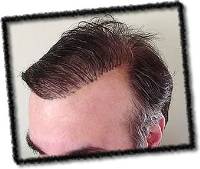In the ongoing battle against hair loss, hair plugs were once considered a state-of-the-art solution. Implantation of hair plugs was popular in the 1980s and is a surgical procedure performed by a medical doctor. After assessing the patient’s hair loss and scalp conditions, the doctor removes sections of scalp (plugs) from areas where hair is healthy and dense, often the from the scalp on the back of the head. A plug can contain as many as 25 hairs and have the diameter of a pencil eraser. Once transplanted to a bald or balding area, the plug continues to grow normally, in effect restoring lost hair to the transplant area.
Click Here To Get More Helpful Information On Hair Plugs And Their Alternatives!
The problem with hair plugs is their size. With this relatively large diameter, even if skillfully placed, they can tend to look bristly, bushy or clumpy. This is especially noticeable at the hairline. In the worst case, the plugs will give the hairline a checkerboard appearance, decidedly unnatural. Fortunately, the procedure has evolved. Modern transplant techniques now deliver a completely natural look.
Even if you’re nearly completely bald, you know that the hair on the lower back of your scalp continues to grow. In this case, the hormone DHT (dihydrotestosterone) which attacks and eventually stops hair growth in individual follicles may cause your baldness. But there are always healthy hairs (and follicles) that resist the attack. The transplant method is now called hair grafts rather than hair plugs. Still a surgical procedure, each individual hair graft section can consist of as few as 2 hairs. Once the hair (and follicle) is “harvested” from the area on the lower back of the scalp, it can be relocated anywhere on the top, crown or hairline. Because the surgeon can work with smaller numbers of hairs in each graft, a natural-looking hairline is easier to achieve.
Unlike hair plugs, hair grafts allow the artistic and strategic placement of hair in thin or bald areas in a way that compliments the patient’s age and face. The results are remarkable. But hair grafts have their drawbacks, too. Usually, there isn’t enough hair on the sides and lower back of the patient’s scalp to do a complete restoration of hair on the top of the head. Only a certain amount of hair can be removed before the donor area starts looking thin.
What if there was a way to produce more hair without utilizing the follicle, without hair plugs or hair grafts? Researchers are experimenting with removing single hair cells from the follicle and replicating them under laboratory conditions. The result is completely new cells that did not exist before. These new cells eventually regenerate into new follicles, in effect creating new hair. So cells taken from a healthy, hormone-resistant follicle can be triggered to produce a completely new follicle that will grow a hair. Once this process is perfected, there will be no limit on the number of hairs that can be produced — all of which will be resistant to subsequent hair loss.
Hair plugs have evolved into hair grafts. There’s no doubt that hair grafts will develop into some other process. But much more is on the horizon. The exciting possibility of creating entirely new hair should be a cause for hope for every person who is experiencing hair loss.
Click Here To Get More Helpful Information On Hair Plugs And Their Alternatives!

